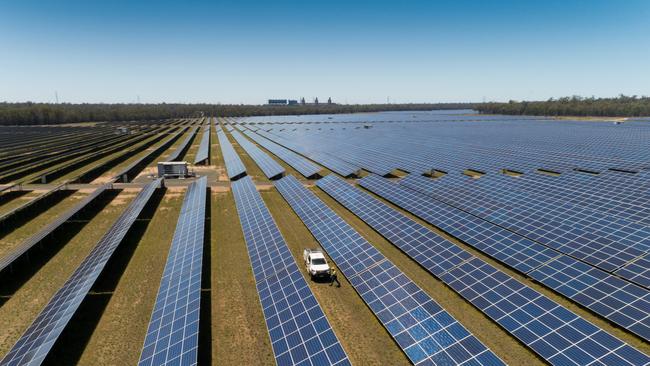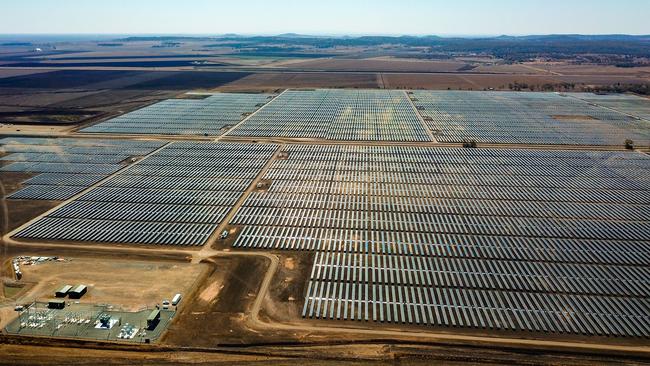Renewable energy: How Darling Downs became green powerhouse
In the space of a few short years, the Darling Downs and southwest Queensland has turned from CSG giant to one of the centres of the state’s renewable energy shift. This is how it got there, and the challenges it still faces.
Toowoomba
Don't miss out on the headlines from Toowoomba. Followed categories will be added to My News.
The Darling Downs is a microcosm of the energy battle that rages across the political spectrum.
It’s a region caught in, and representative of, Australia’s awkward transition into a new age of power generation.
Coal and gas still form a vital part of how we keep the lights on, but renewable energy is a burgeoning industry across the Downs and wider southwest Queensland region.
It’s an area playing host to some of the biggest solar and wind projects in both Australia and the southern hemisphere.
In a few short years, the Darling Downs has shifted its reputation to that of a green energy powerhouse.
And industry lobbyists like Toowoomba and Surat Basin Enterprise CEO Ali Davenport don’t want to stop there.
Ms Davenport said she envisioned Toowoomba and the Darling Downs as the energy capital of Australia, combining these growing industries with fossil fuels to power not just the state but also the country.
Despite the boom, experts say there are many challenges on the horizon, including the life expectancy of renewable projects and the how we store the energy they create.
Growing pains
The genesis of the Darling Downs’ embrace of renewables can be traced back to years before the recent boom in green energy projects.
Energy giant AGL started exploring the possibility of a wind farm in the locality of Cooranga North, which borders the Western Downs and South Burnett council areas, in the mid-2000s and produced its initial assessment on the proposal in 2011.

Stalled for years, the Coopers Gap Wind Farm divided its residents, who splintered off into two opposing groups.
Fuelled by studies that claimed noise and health implications from wind turbines, some residents even marched on Parliament House against the plan as far back as 2013.
AGL formally submitted its application to the state government in 2016, which approved the project less than one year later.
When the $850 million project was finished in 2020, more than 10 years after the idea was floated, its 123 turbines made it the largest wind farm in Australia at the time.
Soon that title will be taken by a new Darling Downs project that broke ground this week.
According to owner ACCIONA Energia, the $2 billion MacIntyre Wind Precinct will generate more than 1000 megawatts of energy and create about 700 jobs across the Southern Downs.
It will be one of the biggest wind farms in the southern hemisphere when completed.
The industry’s growing pains weren’t just in wind power.
A field of solar reflectors glistening in the sun on the outskirts of Dalby were the signs of an industry on the cusp of a boom.
But they never reached their destination – the failed Kogan Creek Power Station Solar Boost Project.
Construction on the solar farm, which was designed to boost the output of the coal-fired power station by up to 44 megawatts, started back in 2011.
The CS Energy project stalled for years before it was ultimately discontinued in 2016.
A report into the failings of the project indicated a “lack of maturity” in the global supply chain, its location, and fabrication and construction quality issues contributed to the failure of the project.
Renewable boom
Just months after the collapse of the Kogan Creek project, the renewables boom began.
Western Downs mayor Paul McVeigh said his region had more than two dozen wind, solar and green hydrogen projects either approved, in construction or completed – virtually all within the past six years.
“We have 23 approved solar farms in the Western Downs, ranging in size from 20MW to 1000MW,” he said.
“Six of those are either completed or under construction, and we have discussions every week with people wanting to develop a solar farm.
“We also have three wind farms – we share one with the South Burnett, and near Jandowae we have a wind farm starting soon, and another at Dulacca, and we expect them to be under construction before the end of the year.
“Going back to Kogan Creek, we are about to have the first commercial hydrogen plant in Queensland, that will be green hydrogen.”

But when asked what fuels would make up southern Queensland’s energy future, Mr McVeigh was clear in his support for coal and gas in the short term.
“I see the need for coal and gas for many years to come, because you can’t just switch off,” he said.
“We don’t have the capacity yet in renewables, it’s in its infancy, we are a different nation to other countries.
“But the future will see a short-term focus on wind, and we’ll see a resurgence of the solar industry, with greater capacity to deliver.
“Coal will be the first we wind down from, but I see gas as being around for a long time as we transition to more reliable renewable energies.”
Four major solar farms are currently under construction.
One of these, the Neoen-owned Western Downs Green Power Hub, will be one of the largest solar farms in Australia when completed.
And there are plenty of plans still in the pipeline.
Vena Energy plans to generate 650 megawatts through its Wandoan South Solar Project, while Solar Choice has an ambitious plan to build a 2000 megawatt solar farm at Bulli Creek, southwest of Toowoomba.
Toowoomba mayor Paul Antonio said the region had a big role to play for both renewable and legacy energy sources, pointing to the council’s own hydro project at Cressbrook Dam.
“I brought a proposition for a pumped hydro scheme and having received advice that it’s worth going on from here, we are proceeding on that journey,” he said.
“The biggest solar farm ever approved is a 2000-megawatt farm west of Millmerran and I understand that battery technology has become available to help capture that,” he said.
“There is a Karrara wind farm, but there is also a group trying to establish a wind farm near Millmerran.
“Innovation as well as renewable energy plays a big role in our future, and we’re a major role in that, to make sure it happens in our community.”
Reasons why
University of Southern Queensland Associate Professor Andreas Helwig said the boom in renewable projects was driven by Australia’s commitment to the Kyoto Protocol and federal government policies designed to meet those goals.
Key among them were grants to cover part of the construction costs.
“Compared to the rest of the world, Australia as a whole has a very small greenhouse gas footprint, but per capita we are one of the worst,” Prof Helwig said.
“Energy generation in Australia is one the biggest contributors to that footprint.”

The result is that the Australian Renewable Energy Agency has helped dozens of projects across Queensland overcome the challenge of bringing solar panels, wind turbines and hydrogen power generators to our shores.
However, to make the sector sustainable in the long term, Prof Helwig said Australia needed to develop its own manufacturing industry.
“We don’t make large inverters, we don’t have a battery industry here, and it is a sector where we are at the end of the industrial supply chain.
“We build the towers that support wind turbines, but we don’t actually build the turbines.”
“For the large 100 megawatt Wandoan South Battery Energy Storage System, we do the site preparations and the install, but the batteries, the monitoring and safety systems are built overseas.”
Bumpy road
The Coopers Gap Wind Farm wasn’t the only southwest Queensland renewables project that had difficulties in its inception.
The community of Sladevale near Warwick fiercely opposed the construction of a 200,000-panel solar farm in the area, which was completed and hooked to the grid in 2020.
Many solar developers have also been engaged in spats with the Electrical Trades Union during construction. Contractors working for Shell QGC on its Gangarri Solar Farm in Wandoan laid off more than 200 staff last year with no notice, prompting a fightback from the union.
The ETU also took on the developer of the Brigalow Solar Farm at Yarranlea in 2019 for complaining to the State Government about requiring licensed electricians to install the solar panels.
The challenges we face
While renewable projects are being developed across the Darling Downs and southwest Queensland, the sector’s future is far from secure.
Wind, solar and hydrogen power face strong headwinds that must be overcome if we have any hope of doing away with fossil fuels.
University of Southern Queensland Associate Professor Andreas Helwig said the big challenge was storage.
“We are behind the eight ball in storage,” he said.
Prof Helwig said Queensland used up to 180 gigawatts hours of electricity each day and would need to store about 1000GWh to cover days when the weather was less than ideal.
On top of that, the efficacy of current storage options, like pumped hydro or lithium batteries, mean we would have to store about 1500GWh to be able to access the 1000GWh to power Queensland.
“At the moment we have something like 4.8GWh of storage,” Prof Helwig said.
“If half the vehicles in Queensland were electric we would have to add another 30 per cent to our storage and generation.”
This means that without significant investment from governments and the private sector, fossil fuels will remain a core part of the energy grid.
The second major hurdle is what we do with the waste.
While coal-fired power plants typically last about 60 years, Prof Helwig said batteries had about a 10-year lifespan while wind turbines lasted about 30 years and solar panels lasted about 25 years.
“We are creating new waste streams that the next generation is going to have to deal with,” he said.
“We will have 20 billion solar panels at the end of their life.”
While a fair amount of this material will be recycled, there is no currently no firm plan on how to do it in a cost effective way.
“The capital replacement cycle is changing,” Prof Helwig said.
“I am all for renewables, but there is a lot of planning, development, infrastructure to understand and commission before we can go away from energy stored in fossil fuels.”
Originally published as Renewable energy: How Darling Downs became green powerhouse




